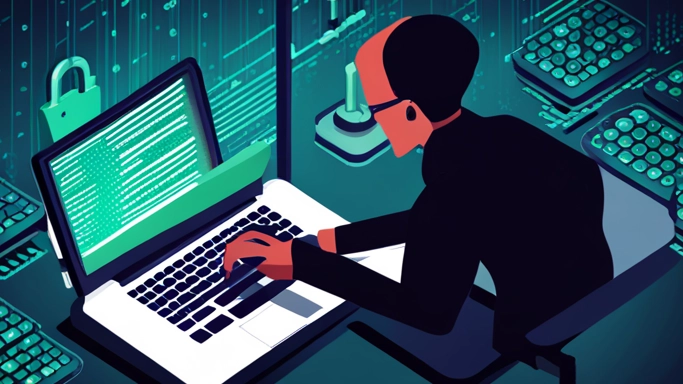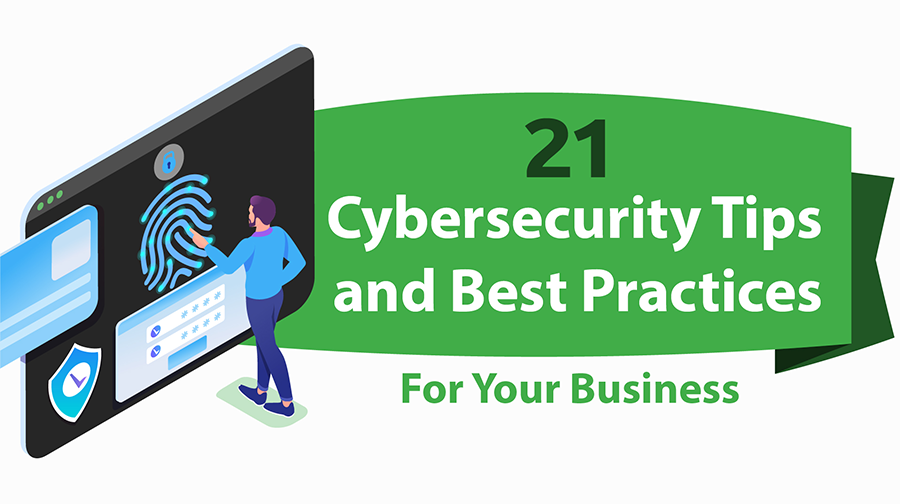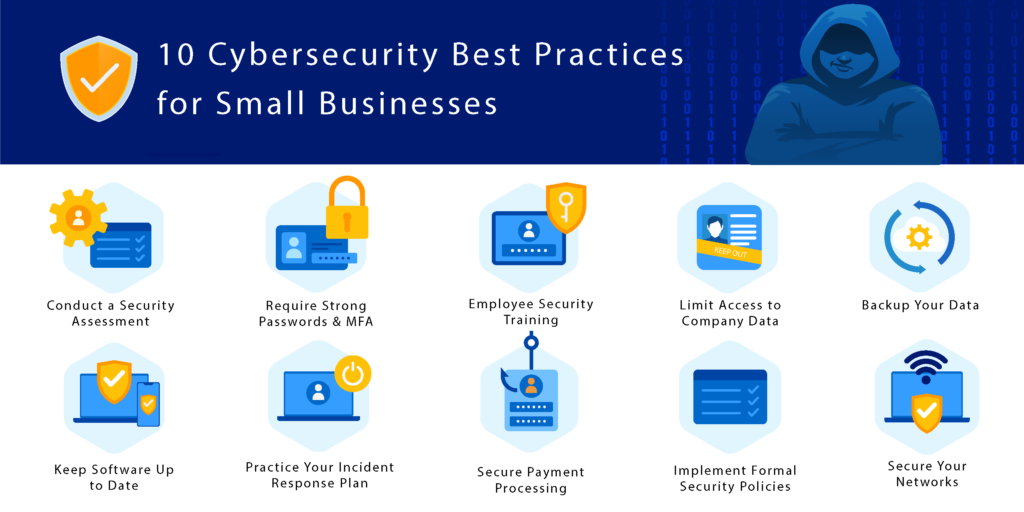Cybersecurity best practices are essential for protecting your digital assets and data from potential threats. We will discuss the key measures you should implement to ensure a secure online environment for your organization.
From using strong passwords and regularly updating software to educating employees about phishing scams and implementing multi-factor authentication, these practices will help safeguard your sensitive information and prevent cyber attacks. By following these guidelines, you can significantly reduce the risk of security breaches and maintain the integrity of your digital infrastructure.
Stay ahead of potential threats and keep your data secure with these cybersecurity best practices.

Credit: networkats.com
Importance Of Cybersecurity
Enhancing cybersecurity through best practices is crucial in safeguarding sensitive data and systems from cyber threats. Implementing strong passwords, regular software updates, and employee training are key measures to prevent breaches and ensure a secure digital environment.
Cybersecurity is the practice of protecting computer systems and networks from digital attacks, theft, and damage to hardware, software, and data. Cybersecurity has become increasingly important in recent years as more and more people use the internet for personal and business purposes. With the rise of cyber-attacks, it is essential to have a robust cybersecurity strategy in place to safeguard your personal and business data.
The Risks Of Cyber Attacks
Cyber-attacks can have devastating consequences for individuals and businesses alike. Here are some of the risks associated with cyber-attacks:
Theft of sensitive information such as credit card numbers, social security numbers, and other personal data
Identity theft
Loss of intellectual property
Reputation damage
Financial loss
Best Practices For Cybersecurity
Here are some best practices you can follow to protect your personal and business data:
Use strong passwords and change them regularly
Enable two-factor authentication
Keep your software up to date
Use antivirus and anti-malware software
Avoid clicking on links or downloading attachments from unknown sources
Encrypt your sensitive data
Regularly back up your data
Train your employees on cybersecurity best practices
Have a cybersecurity incident response plan in place

Credit: www.titanfile.com
Common Cybersecurity Threats
Cybersecurity Best Practices and Common Cybersecurity Threats are crucial topics in today's digital landscape. With the increasing reliance on technology, individuals and businesses are exposed to various security risks that can compromise sensitive information. In this blog post, we will explore some of the most common cybersecurity threats and provide insights on how to protect yourself and your organization.
Malware
Malware, short for malicious software, is a type of software designed to harm or exploit computer systems. It includes viruses, worms, Trojans, ransomware, and spyware. Malware can enter your system through infected email attachments, malicious websites, or software downloads from untrusted sources. To protect against malware:
Keep your operating system and software up to date.
Use a reliable antivirus and antimalware software.
Be cautious when clicking on links or downloading attachments.
Regularly back up your data to an external source.
Phishing
Phishing is a cyber attack where attackers impersonate legitimate organizations to trick individuals into revealing sensitive information, such as passwords, credit card details, or social security numbers. These attacks often occur through emails, text messages, or phone calls. To avoid falling victim to phishing scams:
Be skeptical of unsolicited emails or messages asking for personal information.
Double-check the URL of websites before entering login credentials.
Enable two-factor authentication for added security.
Educate yourself and your team about common phishing techniques.
Ransomware
Ransomware is a type of malware that encrypts files on a victim's computer, rendering them inaccessible until a ransom is paid. It is typically delivered through malicious email attachments or compromised websites. To protect against ransomware:
Regularly update your operating system and software.
Use strong, unique passwords for all accounts.
Be cautious when opening email attachments or clicking on suspicious links.
Regularly back up your data and store it offline.
Best Practices To Protect Against Malware
Cybersecurity Best Practices are crucial for safeguarding against online threats. In this post, we will delve into the Best Practices to Protect Against Malware.
Keep Software Updated
Regularly update your software to patch security vulnerabilities. This helps prevent cyber attacks that exploit outdated systems.
Use Antivirus Software
Install reputable antivirus software to detect and remove malware from your devices. Ensure it is updated and runs regular scans for maximum protection.
Be Wary Of Email Attachments
Exercise caution when opening email attachments, especially from unknown senders. Malware often disguises itself as innocuous files to infiltrate your system.
Best Practices To Avoid Phishing Attacks
Cybersecurity Best Practices and Best Practices to Avoid Phishing Attacks...
Beware Of Suspicious Emails
Phishing attacks often occur through suspicious emails, so it's crucial to be cautious. Avoid opening emails from unknown senders and be wary of any unexpected attachments or links. Also, be cautious of emails requesting sensitive information such as login credentials or financial details. Educate employees about recognizing phishing attempts and reporting them promptly.
Verify Website Authenticity
Verifying the authenticity of websites is essential to prevent falling victim to phishing. Always check the URL for misspellings or slight variations that might indicate a fraudulent site. Look for secure connections indicated by "https" and a padlock icon in the address bar. Additionally, utilize website reputation tools and security software to verify the legitimacy of the sites you visit.
Use Multi-factor Authentication
Implementing multi-factor authentication adds an additional layer of security to protect against phishing attacks. By requiring users to provide multiple forms of verification, such as a password and a unique code sent to their mobile device, it significantly reduces the risk of unauthorized access. Encourage the use of biometric authentication where possible, as it enhances security and user experience simultaneously.
Best Practices To Prevent Ransomware Attacks
Cybersecurity best practices are crucial in safeguarding against digital threats. This blog post focuses on best practices to prevent ransomware attacks, which can have devastating consequences for individuals and businesses alike.
Backup Data Regularly
Regular data backups are essential to minimize the impact of ransomware attacks. Backing up data to secure, offsite locations or cloud services can ensure that critical information remains accessible, even in the event of a security breach. It is advisable to create automated backup schedules and verify the integrity of backups regularly.
Be Cautious Of Unknown Sources
Exercise caution when interacting with unknown sources, such as email attachments or links from unfamiliar senders. Implement robust email filtering to detect and quarantine suspicious messages. Additionally, consider utilizing endpoint protection solutions to prevent malicious software from infiltrating your systems through untrusted sources.
Educate Employees
Educating employees about cybersecurity best practices is paramount in mitigating ransomware risks. Provide comprehensive training on identifying potential threats, adhering to security protocols, and reporting suspicious activities promptly. Encourage a culture of vigilance and awareness to fortify your organization's defense against ransomware attacks.

Credit: www.psmpartners.com
Importance Of Strong Passwords
With the increasing dependence on technology and the internet, it has become crucial to prioritize cybersecurity. Protecting sensitive information and personal data from cyber threats is essential for individuals and businesses alike. Implementing best practices can significantly reduce the risk of cyber attacks and ensure a safer online experience. In this blog post, we will discuss the importance of strong passwords and provide some guidelines to create and manage them effectively.
Creating strong passwords is the first line of defense against unauthorized access to your online accounts. Weak passwords are vulnerable to brute-force attacks and can be easily cracked by hackers. To enhance the security of your accounts, follow these best practices:
Use a combination of uppercase and lowercase letters: Mixing uppercase and lowercase letters in your passwords makes them harder to guess.
Include numbers and special characters: Incorporating numbers and special characters further strengthens your passwords.
Avoid using common words or personal information: Hackers often use automated tools that can easily guess common words or personal information like names, birthdates, or phone numbers. Avoid using them in your passwords.
Make your passwords long: Longer passwords are more secure. Aim for a minimum of 12 characters.
Don't reuse passwords: Using the same password for multiple accounts increases the risk of a security breach. Always create unique passwords for each account.
By following these guidelines, you can significantly improve the security of your online accounts and reduce the chances of falling victim to cyber attacks. Remember, your password is the key to your digital presence, so make it strong and keep it secure!
Best Practices For Password Security
Cybersecurity Best Practices and Best Practices for Password Security are crucial in safeguarding your online accounts from unauthorized access.
Create Complex Passwords
Creating complex passwords involves using a combination of uppercase and lowercase letters, numbers, and special characters to enhance security.
Use Password Managers
Password managers help store and generate strong, unique passwords for each of your accounts, reducing the risk of password-related breaches.
Enable Two-factor Authentication
Two-factor authentication adds an extra layer of security by requiring a secondary verification method, such as a code sent to your phone, along with your password.
Frequently Asked Questions
What Is Cybersecurity And Why Is It Important?
Cybersecurity is the practice of protecting computers, servers, mobile devices, electronic systems, and networks from digital attacks. Cybersecurity is important because it ensures the confidentiality, integrity, and availability of information and systems.
What Are Some Common Cybersecurity Threats?
Common Cybersecurity threats include phishing attacks, malware, ransomware, social engineering, and denial-of-service attacks.
How Can I Protect Myself From Cybersecurity Threats?
You can protect yourself from Cybersecurity threats by using strong passwords, enabling two-factor authentication, keeping your software updated, avoiding suspicious emails and links, and using a VPN.
What Are Some Cybersecurity Best Practices For Remote Workers?
Some Cybersecurity best practices for remote workers include using secure Wi-Fi, avoiding public networks, using a virtual private network (VPN), encrypting sensitive files, and using two-factor authentication.
How Can Businesses Improve Their Cybersecurity Practices?
Businesses can improve their Cybersecurity practices by conducting regular risk assessments, implementing strong password policies, providing employee training, keeping software up to date, and using encryption for sensitive data.
Time Management for Parents: Boost Efficiency Now!
Conclusion
Implementing strong cybersecurity best practices is crucial for protecting your digital assets. By following the tips outlined in this blog post, you can enhance your online security and minimize the risk of cyber threats. Remember, staying informed and proactive is key to safeguarding your data and privacy in the digital age.
